Click Here if you listened. We’re trying to gauge interest so only one question is required; however, there is a spot for feedback!
Read along below!
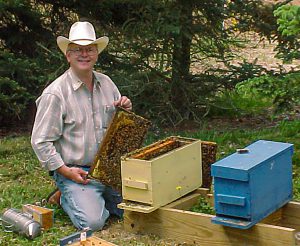
James E. Tew with two splits (Circa 1995)
Buying and Establishing Bee Colony Splits
Lots of suggestions, but not many rules
By: James E. Tew
No doubt, you’ve heard this before
When either presenting or listening to a discussion on increasing bee colony numbers, there is always an informational requirement to list the four major ways to increase colony numbers: (1) Buy a package of bees, (2) Buy a colony split, (3) Capture a swarm or (4) Purchase a fully functional colony from another beekeeper (Removing bees from a building or a tree is an unlisted specialized method of acquiring bees. For most of us, such events do not routinely occur).
Nearly always, the presenter then elucidates the advantages and disadvantages of each option. Procuring a swarm requires good luck and purchasing a colony requires just about as much luck, but much requires more monetary investment. The two surest options for increasing (or replacing) colony numbers are buying a package or buying a split.
Package bees
Purchasing a package of bees is the tried-and-true option for getting new bees at a time when you are most prepared for them. While I have always enjoyed installing packages, some common problems can present. Maybe something goes wrong with the queen. Maybe the bees drift to other colonies. But I suspect the most routine negative characteristic of package installation is the adult bee population drop that begins to occur within a few days after the package is installed. This happens every time and in every package.
In total, it takes a serious amount of time for the queen to become established, begin laying, brood to develop and then twenty-one days later, for new workers to emerge – maybe four to five weeks. Therefore, four to five weeks after the installation date, the beekeeper has significantly fewer bees in the hive than when the package was originally installed. Any worker bee that died during that broodless period was not replaced.
Colony splits
Colony splits with established queens on a brood nest eliminate the characteristic population decline that is experienced with package bees. Those are the main selling points for colony splits. The split comes with an introduced queen that should be laying the entire time that the colony is being established in your yard. So why does anyone ever buy a package? Because they are readily available.
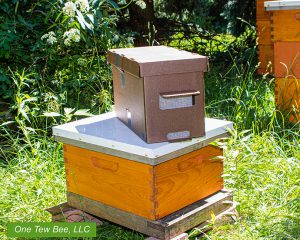
Figure 1. A five frame split awaiting transfer to standard equipment.
There has never been an established bee industry infrastructure for routinely producing and distributing splits. Every season, you and I must search for someone who has decided to split their bee colonies and equipment from their established colonies, provide a queen, and sell these “baby” colonies. The cost in time, and energy from both beekeeper and bees is significant, so the selling cost of the split is always more than the selling price for a package.
In general, I prefer splits over packages, but the split-purchasing and installing procedure can be more complicated and costly than the simplicity of package usage.
In all my years of buying packages and splits, I have found that for me, personally, the confusion is in the details. What details? Well, there’s quite a few. In no order of priority, I would like to review some of these characteristics below.
Detail #1 – Split vs Nuc
Splits and nucs are essentially the same bee hive component, but not exactly. In my opinion, a split is a type of nuc that is intended to grow into a fully functional colony. That can’t be said of all nucs (aka nucleus hives or nucleus colonies). For instance, some nucs are only intended to be a component of queen production. They will never grow to full-sized colonies. Other nucs have specialty functions such as populating an observation hive or possibly being used as a component of a colony cut-out procedure (removing a bee colony from a building). Various sizes and components of nucs frequently have significant use in the scientific community and research organizations. A nucleus hive is frequently just for the moment.
In a way, a nucleus hive could be said to be comparable to a cutting taken from a plant. How big was the cutting? How was the cutting rooted? When, during the season, was the plant cutting taken? A nucleus hive is just a bee colony “cutting.” Details and specifics abound.
Detail #2 – Where to find a split colony purveyor?
A few paragraphs ago, I wrote that a nucleus hive is frequently just for the moment. In a way, I want to write that finding someone to sell you colony splits is also for the moment (or season). I ask around. I have contacts from previous seasons. I read advertisements in journals and newsletters. I see online messages. In general, I try to make good luck happen when searching for a producer. In a few instances, the producer was actually just doing me a favor and was not in the split-producing business. In fact, only in a couple of instances have I purchased splits from the same person more than two consecutive seasons. Why? Let’s go with that discussion in Detail #3 below.
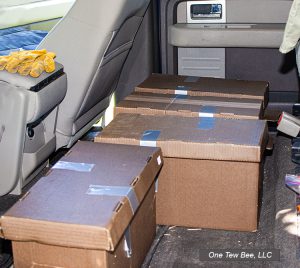
Figure 2. Paper nucs boxes filled with a colony split ready for the ride home.
Detail #3 – Why produce splits for sale?
There is no single standard reason that jumps out to me that justifies someone splitting their colonies. Monetary income is the clear and present reason, but that is always hard-earned money. Other than money, it could be local reasons. Maybe the beekeeper who is interested in selling splits is in an area that provides good early Spring buildup and is followed up with a good main nectar flow. They have bees, but those bees do not make a lot of honey. So, they sell bees and not honey.
A producer may be trying to prevent upcoming swarming behavior. To limit that behavior, the beekeeper simply removes some of the bees and brood from the brood nest. Maybe the beekeeper has more colonies than can be maintained. Maybe the beekeeper is interested in doing something different that will provide a needed flush of extra income.
Bottom line? I don’t know exactly why someone decides to produce splits for sale. Other than large production companies that have management sophistication beyond that of a typical beekeeper, most split producers have limited production capacity and are local. In my bee life, providers vary from season to season.
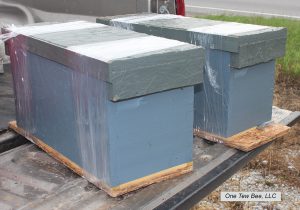
Figure 3. Nuc boxes improvised by cutting a deep hive body in half. J. Kerns photo.
Detail #4 – What am I paying for?
You are paying for whatever you have negotiated. Unlike three-pound packages, there is no “standard” split. Three, four or five frame splits are common. The producer should tell you how much honey, pollen, brood and bees will be in the split. Yes, you will probably be buying the beekeeper’s older combs. In some instances, you will want to phase them out as soon as possible.
Nowadays, producers rarely require the frames and equipment to be returned to them. The equipment is included in the selling price. It becomes yours. Being an old guy, I can tell you that in decades past, I was required to provide new frames and foundation and to return the nuc box, but mites and viral diseases have put a damper on that requirement. Though it surely increased the selling price, not requiring equipment replacement made the split transition simpler.
Throughout this entire encounter, if the provider is marketing to others and not only doing you a favor, be sure they are inspected by the state apiarist and are approved for selling “baby” colonies. In fact, you want to know that answer even if the provider is a friend who is trying to help you out. Without a doubt, you are going to be buying varroa mites in the deal but you do not want to be buying American foulbrood, too. Always be alert.
Detail #5 – Speaking of nuc boxes
In what kind of box do you transfer the split to your home yard? For sure, ask that question during the transaction period. I have had experience with two broad types of transfer boxes – wood and temporary (paper or corrugated plastic). I felt best about the wood boxes but acquiring a permanent five-frame wooden nuc box obviously increased the selling price. Years later, I still have several wooden boxes in my bee operation that I acquired from various nuc-split deals.
Wax-coated paper nucs are popular as temporary bee hive boxes, especially for splits. In my mind, I live in a perfect bee world, so in that perfect world, I plan to bring these small colonies to my home yard and immediately transfer them to standard equipment. There, they will live happily ever after. However, the following saga describes what happens in the real bee world.
I bought about twenty five-frame splits from a respected provider about one hundred miles from me. I made the trip and loaded the splits onto a small, open trailer. Using common duct tape, I attached the lid to each paper box and then ratchet-strapped rows of boxes to the trailer. Of course, it was going to rain on me and my new bees on the trip home. It did.
Upon arriving at home, I found that on two boxes, the dampened lids had bent back – due to the wind velocity – and had exposed the internal colony to highway wind speed. I essentially scattered some bees up and down the interstate. Worse, one lid was completely gone. I still had some bees in the open boxes, but the populations had been reduced. But the story does not end here.
After I arrived at home, the weather prediction only grew worse. I hurriedly got the boxes set up in my yard and placed a brick on each corrugated paper colony. After getting back to my easy chair at home, it became official. Within a few hours, a storm was to pass through my home town with high winds and heavy rain. Back to the yard I raced, with a different enclosed box trailer that was not truly road worthy. I hurriedly placed the colonies within the enclosed trailer scattering bees everywhere. As I was working, I took a second to wonder if the high winds would now destroy both the bees and the trailer.
The storm passed. The trailer, and the protected the paper-housed hives, survived without incident. The next day, I got the bee splits set out again and transferred to them to standard equipment. Yep, there was flight confusion and drifting, but ultimately everything settled out.
My point for this long story? When I casually agreed to wax-papered nuc boxes, I did not envision a rainy drive home and subsequent high wind and rain storms before I could get the splits into permanent boxes. As usual, I envisioned a perfect bee world. I suggest that you have a doomsday plan for what to do if things do not go as planned.
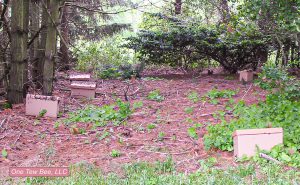
Figure 4. Some of the paper nuc boxes the next day. I left lids askew to aid lost bees in finding a home.
Detail #6 – All things queen-related
No doubt, the reason more beekeepers do not produce splits is queen availability needed to head the splits. Yes, some rarified few beekeepers are set up to produce a few queens of their own, but many of these producers must buy queens at a time when they are most in demand. The type and caliber of the queen will vary from producer to producer.
Honestly, this is difficult to put into practical wording, but I must try. Your goal with this split is to get the colony established. In the real world, your primary requirement is that the queen’s ability is great enough to establish a successful brood nest and stabilize the colony with her pheromone output. I would suggest that if she is able to do that, the producer has met their obligation to you.
In the perfect bee world, you would get a high-dollar, fancy-bred queen that would lead the young colony to population greatness in a short time. In the real world, you just hope to get a queen that can lead the young colony to accumulate enough colony resources to survive the next Winter that is still months away. In my case, I am only trying to get the small colony stabilized. Once the split colony is on firm survival ground, I may then decide to upgrade the colony’s queen leadership.
What’s to prevent the provider from selling me an old queen? Honestly, not much. The good news is that the provider will probably not have a large inventory of old queens. But while I don’t really want a queen that’s already approaching her supersedure time, if she is productive enough to stabilize the colony and importantly, if the colony’s worker bees have shown that they are okay with her, then so be it. I just wrote before that I may very well be considering replacing the queen anyway. Even a new, young queen may be superseded by finicky nurse bees. Nothing is assured. At the risk of repeating myself, I feel that the primary goal is to get a stable, established colony that I can work and manage as it develops into a full-featured colony.
Detail #7 – The season
If the split provider let the baby colony produce its own queen, then I and my new bees have already missed the early Spring nectar and pollen flow. That part of the season had to be used to grow the queen. I need to be prepared to feed this young colony as it tries to accumulate enough resource wealth to Winter its first major dearth. To assist this small colony, in addition to supplemental feeding, I will need to perform all the beekeeper assigned tasks like varroa control and small hive beetle suppression.
The queen’s output and the season are interrelated. Sometimes the queen just does not work out. If you have enough of the season remaining (you must decide that answer), then replace her. If the season has progressed to the typical Summer dearth – or even into Autumn – you and your new colony may be better off to pass the Winter with a subpar queen leading the colony. Hey, no one said beekeeping was always easy.
Detail #8 – Failure
What recourse do you have if the splitting project fails? Honestly, not much. I am not defending producers, but many things and seasonal events are beyond their control but it’s not just about failed splits. What recourse do you have if a package project fails? Not much. Are all hived swarms successful? No. As you know, there are no guarantees in any aspect of beekeeping.
If you truly feel that what was in your nuc box when you got home was not what you negotiated, certainly you can complain, but I doubt much will come of it. I am sure you will not return to that provider next season and I also expect that you will quietly let others know of your negative experience. I feel a need to say that I have never been given a split that seemed to be significantly less than what I bargained for. No doubt, some of you have other stories.
 Have you heard Bee Culture magazine?
Have you heard Bee Culture magazine?
By clicking on the computer code (QR Code) at the beginning of this article, you can go to Bee Culture’s audio-article web page. In the audio version of my article, in addition to my monthly article, I have posted extra comments and details that I don’t have space to address in written form.
Have you heard Honey Bee Obscura?
Some weeks ago, Kim Flottum and I posted a podcast at HoneyBeeObscura.com where we discussed conversational aspects of buying and managing splits. It’s free. Have a listen.
As always, thanks for reading (and listening).
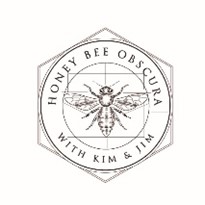 Dr. James E. Tew
Dr. James E. Tew
Emeritus Faculty, Entomology
The Ohio State University
tewbee2@gmail.com
Co-Host, Honey Bee
Obscura Podcast
www.honeybeeobscura.com






